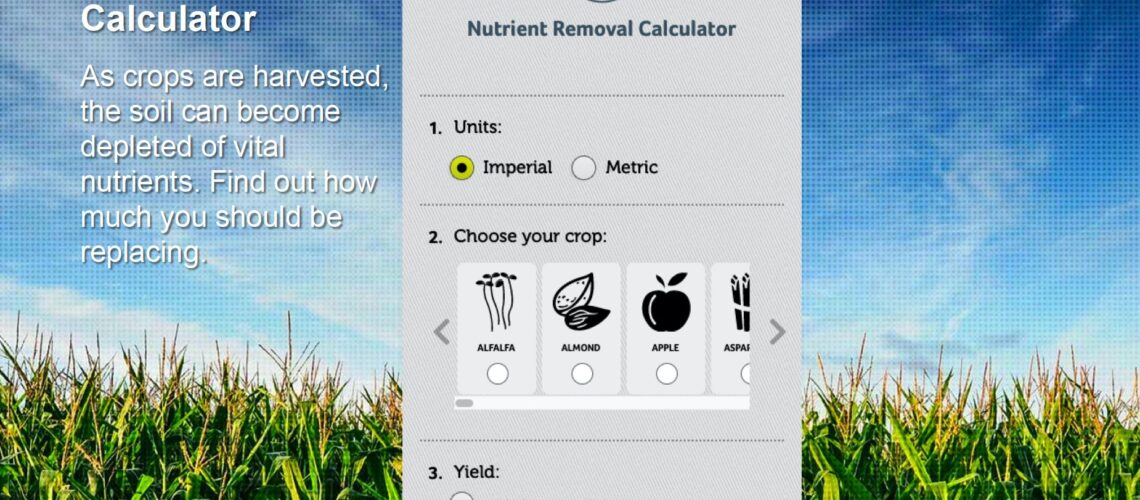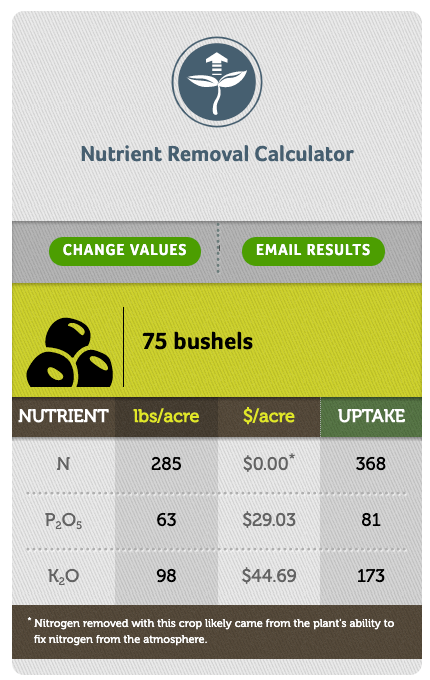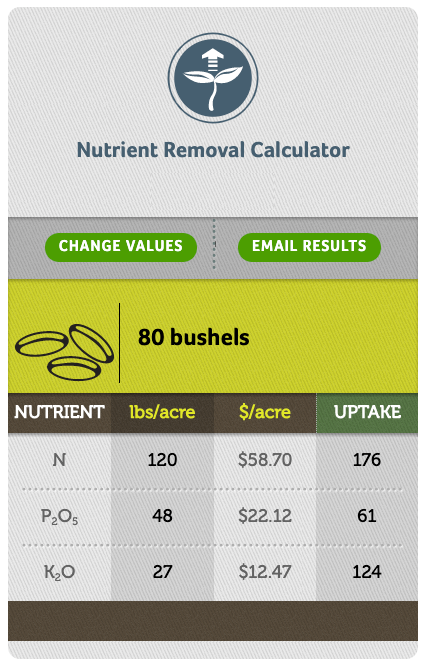Nutrient Removal Calculator: Benefits & Use

eKonomics’ Nutrient Removal calculator estimates crop nutrient removal of nitrogen (N), phosphorus (P), and potassium (K) for a broad list of field crops. Results are calculated based on selected yield goals and can be displayed in either metric or imperial units. You can also calculate economic impact by adding cost to your NPK application amounts. The results will include price per acre with your nutrient uptake estimate. Overall, the Nutrient Removal calculator is a great tool to use when determining the amount of nutrients that need to be replaced in your soil.
Use the Nutrient Removal Calculator Tool
Benefits of Using the Nutrient Removal Calculator Tool
By entering your expected or previous crop yield into the Nutrient Removal calculator tool, you can see how much nutrient was removed and how much will need to be supplied to ensure you maintain your soil test level and push productivity.
When viewing how much NPK has been removed, you should always consider your soil test level. If the level is low and you are only supplying the nutrients being removed, this will not increase your soil test level. Application rates will need to be increased to see the level build over time. Using the Nutrient Removal calculator will help you determine how much NPK has been applied and how much uptake will come from the selected crop.
Additional features include imperial and metric measurement, making the tool suited for use in the U.S. and Canada. The economic cost estimate will help budget for nutrient application and is calculated in U.S. Dollars.
Listen to eKonomic’s Senior Agronomist, Cristie Preston, Ph.D. discussing the maintenance vs. build approach in calculating nutrient removal rates and how using the tool can help:
Calculating nutrient removal rates: maintenance vs. build approach
Skip to 2:20 on the video to reach the Nutrient Removal section.
How to Use the Nutrient Removal Calculator Tool
Unit selection will set your unit preference and allow you to enter crop yields and nutrient costs in either imperial or metric systems.
You can use the economic impact button to find the value of the crop nutrients being removed. This feature will require you to input your nutrient sources and costs.
If you do not know the current nutrient prices in your area, consult your local retail agronomist.

1) Unit selection: Choose your unit preference of imperial or metric.
2) Crop selector: We have assembled crop removal data for a large number of crops from scientific publications from around the world.
3) Yield: Enter a potential yield based upon previous experience or what your crop actually yielded.
4) N source selector: Select a nitrogen source that you are likely to use to fertilize your next crop.
5) N cost: Enter a cost for that product. You can use a reported value or a local value.
6) P source selector: Select a phosphorus source that you are likely to use to fertilize your next crop.
7) P cost: Enter a cost for that product. You can use a reported value or a local value.
8) K source selector: Select a potassium source that you are likely to use to fertilize your next crop.
9) K cost: Enter a cost for that product. You can use a reported value or a local value.
General Rules of Thumb
You can find the impact of crop removal on soil test level by using the following general rules of thumb:
- For every 20 pounds of phosphorus removed without fertilization, soil test level will decrease by 1 ppm.
- For every 6 pounds of potassium removed without fertilization, soil test level will decrease by 1 ppm.
- Incorporating these general rules of thumb can aid your discussion by seeing that skipping fertilization will decrease soil test level for subsequent crops.
Going Beyond the Basics
Here we provide two scenarios to demonstrate how the Nutrient Removal calculator tool works.
Scenario One

Review the selected unit measurement, crop type, yield, and economic impact nutrient values in the scenario one calculator tool example.
Click “Calculate.”

The results reveal that 285 pounds of nitrogen was removed with a value of $0 (because legumes replace their own nitrogen naturally, no dollar amount will be attributed to the nitrogen’s removal), 63 lbs of P2O5/acre were removed with a value of $29.03, and 98 lbs of K2O/acre were removed with a value of $44.69.
How will this theoretically impact subsequent soil test levels?
Soil test phosphorus level would decrease by 3 ppm and soil test potassium level would decrease by 16 ppm (remember the general rules of thumb).
Scenario Two

Review the selected unit measurement, crop type, yield, and economic impact nutrient values in the scenario two calculator tool example.
Click “Calculate.”

The results reveal that 120 lbs/acre of nitrogen was removed with a value of $58.70, 48 lbs/acre of P2O5 was removed with a value of $22.12, and 27 lbs/acre of K2O was removed with a value of $12.47.
How will this theoretically impact subsequent soil test levels?
If only grain was removed, soil test phosphorus level would decrease by 2.5 ppm and soil test potassium level would decrease by 4 ppm (remember the general rules of thumb).
If grain and straw were removed, soil test phosphorus level would decrease by 3 ppm and soil test potassium level would decrease by 20 ppm.
Nutrient Uptake and Removal
When developing a nutrient management plan, there are two essential concepts to utilize: nutrient uptake and nutrient removal. Nutrient uptake is the amount of each nutrient required for the crop to complete its life cycle at a given yield level. Nutrient removal is calculated by taking the concentration of each nutrient in harvested material and multiplying by the harvest yield. Discover more about the differences and how they are used to calculate the nutrient harvest index:
The difference between nutrient update and removal including how they are used to calculate a nutrient harvest index.
Soil Testing
It is advisable to take several soil samples to get an estimate of the average nutrient removal rates. Do not put too much weight on just a few samples. If you are unsure of your analyses, consult an agronomist.
Always keep good records. It’s important to retain analysis sheets as well as moisture and test weights if available. The more analyses you collect, the better your average estimate of local nutrient removal rates will become. Supplemental information about the samples may also be useful when interpreting analysis results.
If possible, gather information about manure application history, crop history, soil test levels, hybrid/variety, planting date, and any other information you think may impact nutrient removal rates in your area.
Review these steps to help you achieve an ideal soil sample in the fall:
4 steps to achieving the ideal soil sample this fall



